
Sara Anderson by Laura Callaghan.
Every now and again fashion week throws up something truly astonishing that I didn’t know about before… and on this occasion that honour must surely go to the unexpectedly fabulous graduate show from the Swedish School of Textiles, view showing for the first time at LFW. I sat with my old intern Sarah Barnes of Uplift Magazine, information pills so we had a good chance to catch up on the gossip before the show started to a very under capacity audience.
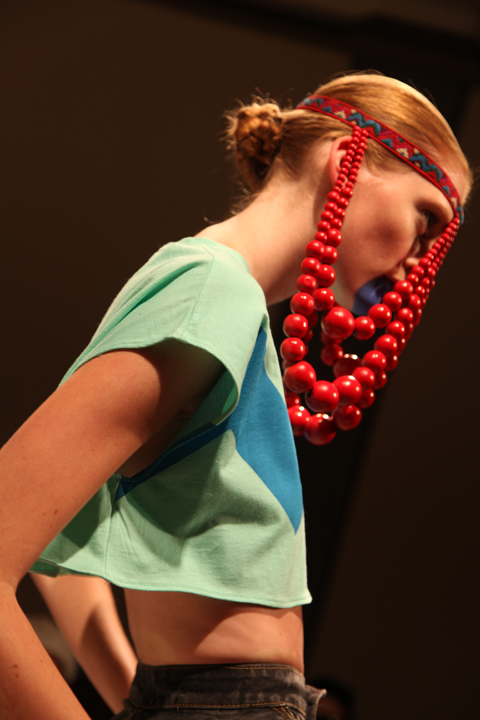

Stina Randstad. All photography by Amelia Gregory.
Of course, buy more about it is to be expected that the crowd might be a little sparse for the first year that someone shows at LFW, but it is nevertheless somewhat bemusing to be provided with so little information about the contributing graduates; nothing beyond the flimsiest of explanations on our seats. Not even a list of designers! It baffles me that an institution would go to all the cost of sending their graduates over to the UK and then neglect the most basic of PR opportunities. To keep up I had to take photos of the projection of the back wall between collections, and then squint through them to label each designer correctly. About the individual students I know nothing more.
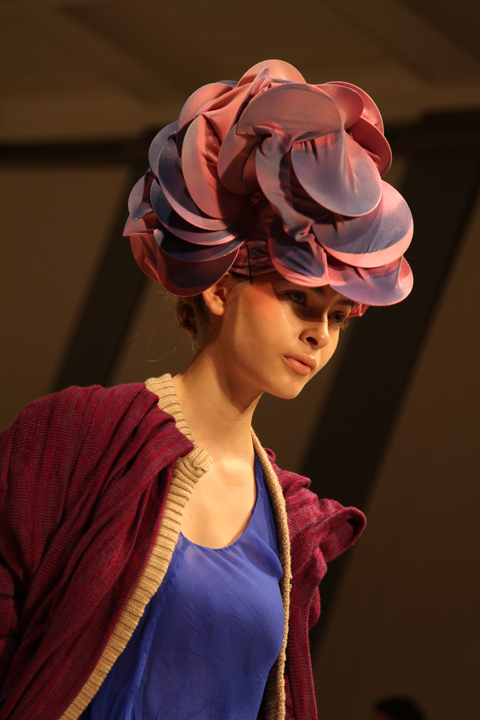

Emelie Johansson.
I had absolutely no expectations bar a pretty good gut feeling that as a former textile designer myself I was going to like what I saw. I could not have been more on the mark.
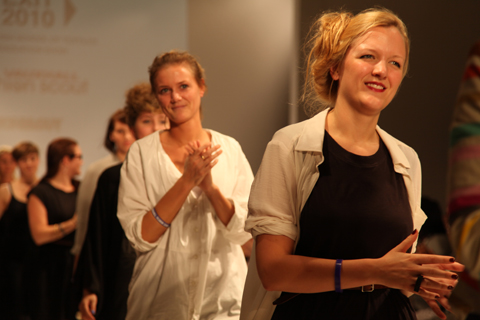
Students rollcall.
The opening collection, Prepositions by Sara Anderson, was a pretty good indicator of things to come. Models strode down the catwalk in what looked like the lime and carrot angular offcuts of some 60s furniture factory mishap – great angular bulks attached to head, waist and shoulder. Glistening metallic fabrics and foiled polka dots completed the look. And instantly my interior art director gremlin was hopping up and down with excitement just thinking about what our illustrators could do once they sunk their teeth into this.

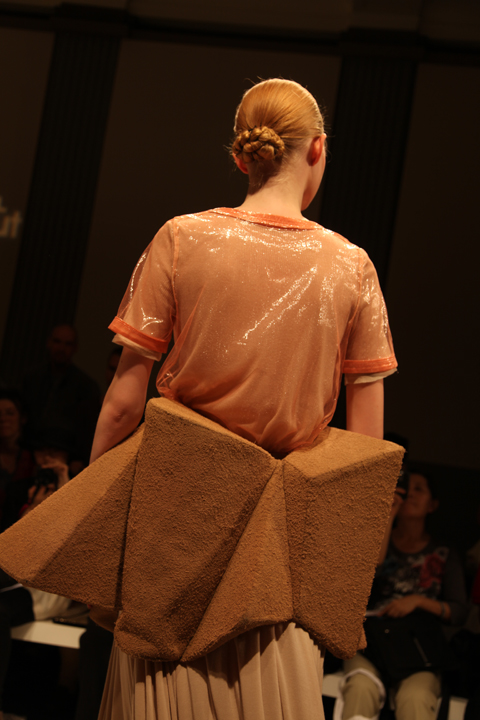
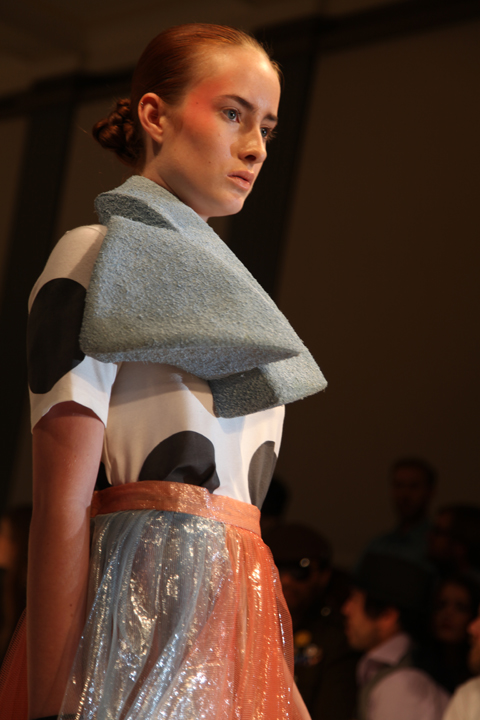

Sara Anderson.
Next up was a fabulous menswear collection from Johanna Milvert. Just the right side of barking, it featured massively oversized sleeves and bulbous mismatched proportions that cocooned the models in deep orange deck chair stripes and ribbed knits. A lopsided leather man bag was a particularly individual touch.


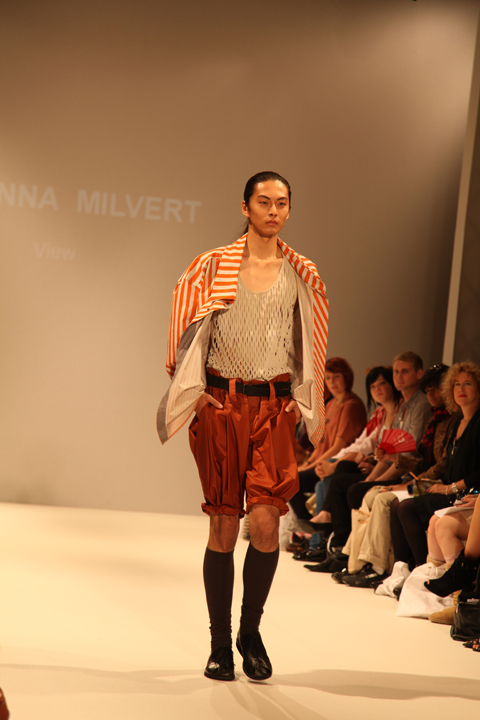
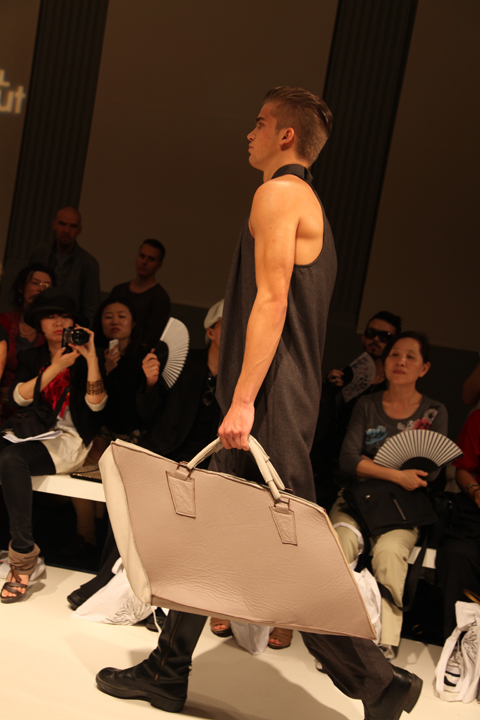


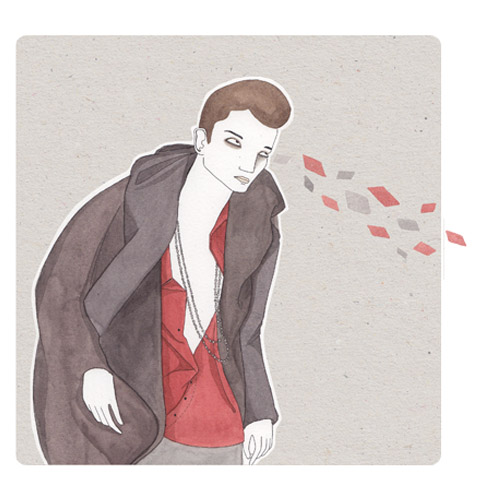
Johanna Milvert by Laura Callaghan.
This was followed by a relatively calm collection, Efterklang by Elin Klevmar, in which the lopsided theme continued apace as the models strode down the catwalk in softly draped pebble and cream coloured loungewear.

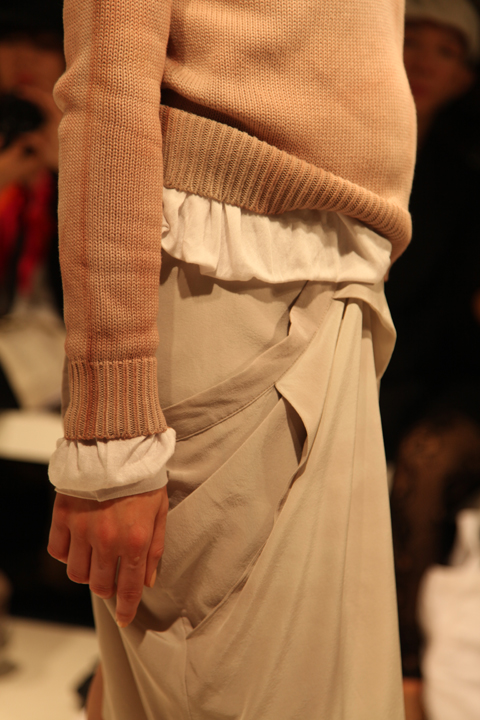
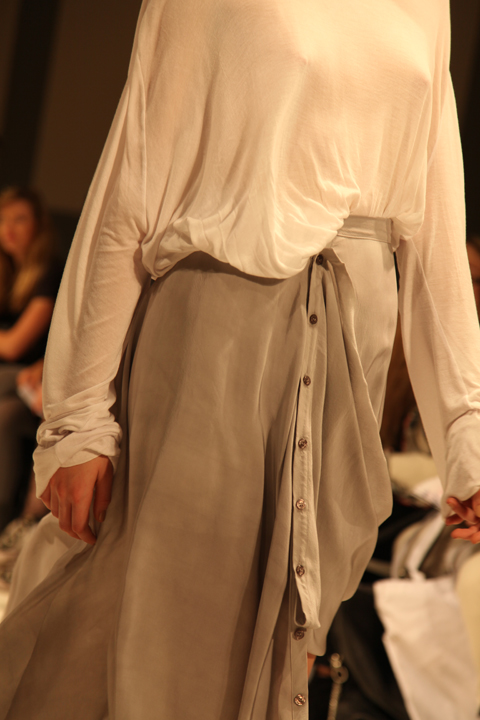

Stina Randstad’s Breed hit the catwalk in an outrageous large shouldered ruffled denim affair that Leigh Bowery would have been proud to wear. Mixing African fabrics, Scottish tartan and 80s pop art club kid inspired prints shouldn’t work but it somehow did – we need more of this kind of inspired madness at the shows. Tartan rara skirts, veil like head necklaces, knitted cockerel crests, crazy facepaint and huge superhero shaped tailoring: this collection really did have it all… and I say that in a good way.


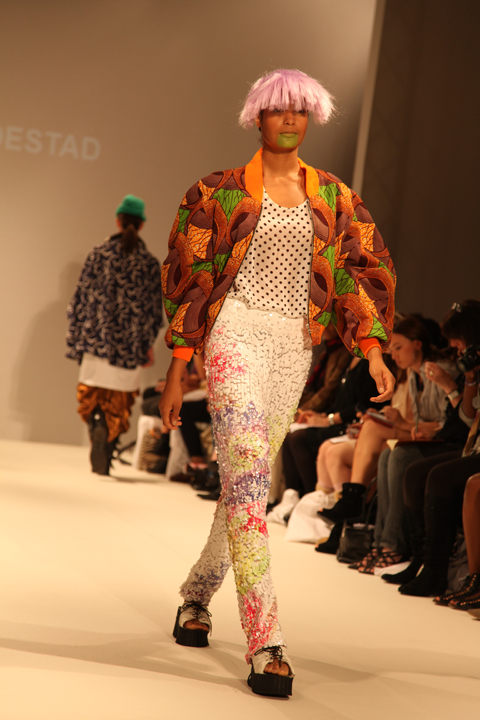
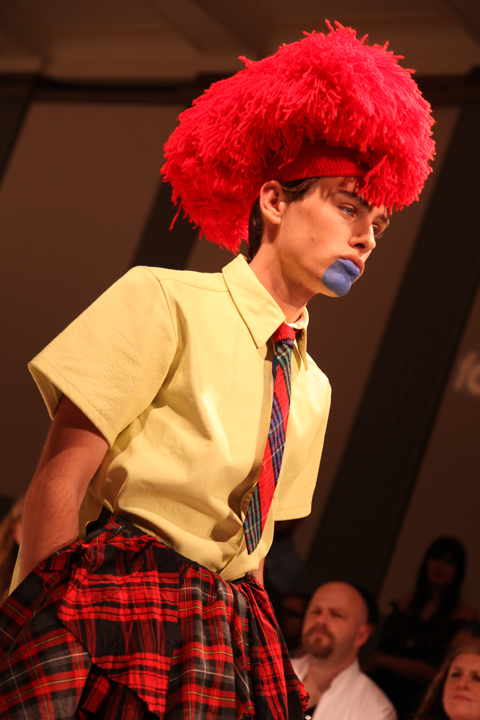
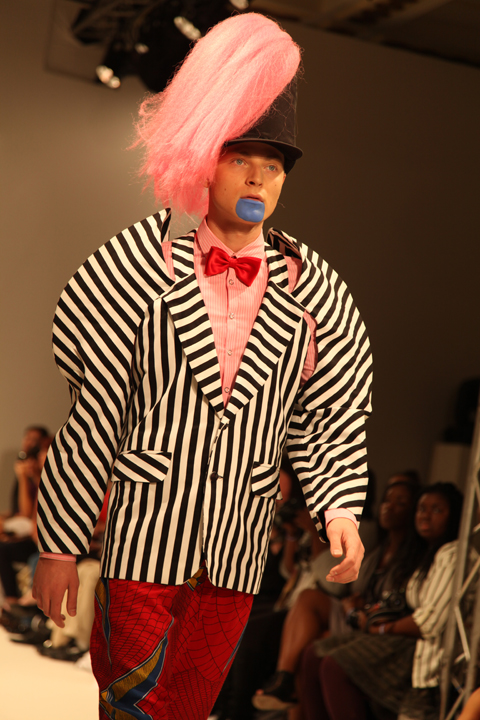

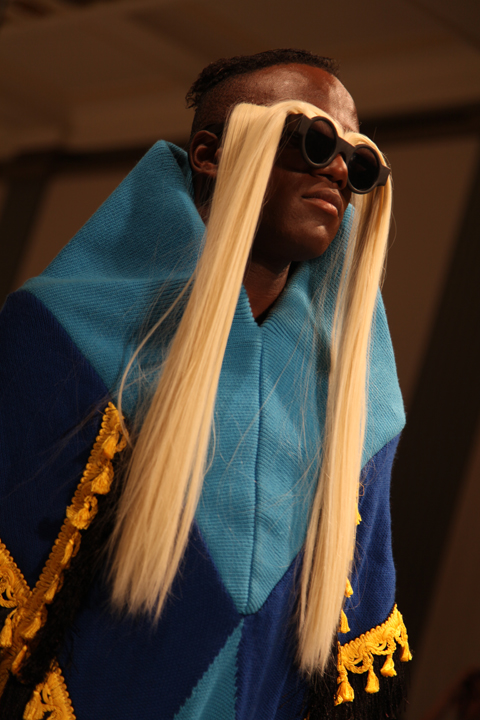
Stina Randstad.
Structure is Everything by Emelie Johansson appeared to have been influenced by coloured pencil shavings. Taking oversized accessories to the next level some of the headdresses resembled alienesque head tumours that would surely not look out of place on the deck of the Starship Enterprise. Peeking out from beneath the styling madness were some really wonderfully constructed primary coloured garments.

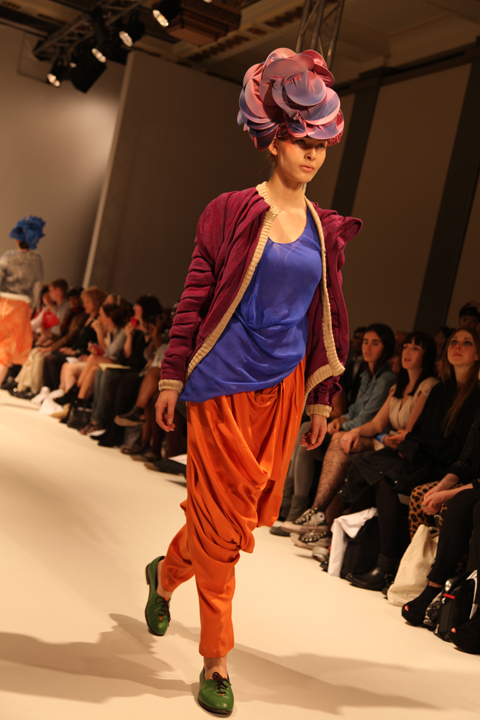
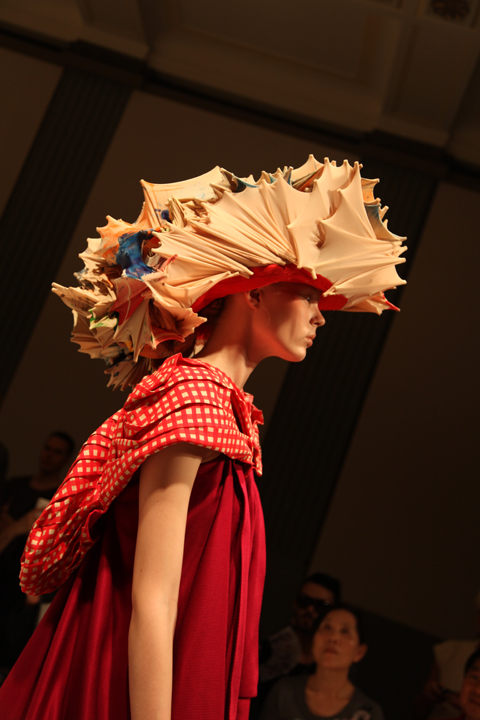

Emelie Johansson.
Another menswear collection from Jennie Siljedahl – Control Me As I Control You – showcased autumnal themed pieces in quilted golds, reds and burnt orange, all accessorised with big recycled necklaces and arm jewellery. I particularly liked the overgrown eyebrow glasses.

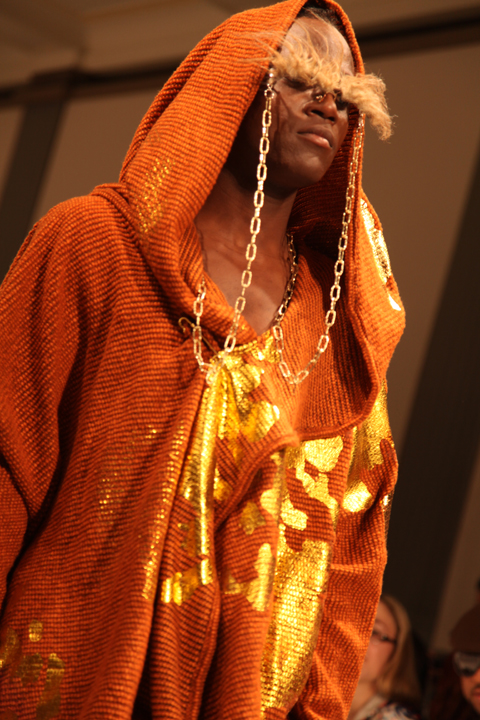

Jennie Siljedahl
Elin Sundling’s monochrome collection I Paint Myself Into A Corner featured models who looked as if they had been dragged through the cobwebs of an attic – gauzy face netting gave a sinister feel to (another) lovingly cut lopsided collection that featured some fabulous dusty and oily prints.





Elin Sundling.
For sheer styling nuttiness though the prize had to go to Ellinor Nilsen with Nobodies – who sent models down the catwalk in strange eyeless masks, fake hair protruding from all the wrong places in all the wrong colours. One can only presume the models practiced beforehand by counting their steps, for it all went off seamlessly. Beneath the amazing masks knitwear and tailoring took inspiration from the hairy fuzzy scratchy parts of bodies. Particularly odd was a hair print dress. Unlike anything I’ve ever seen.
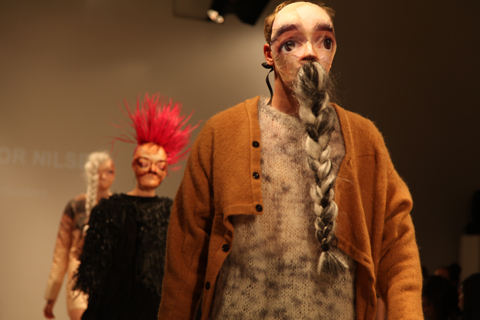



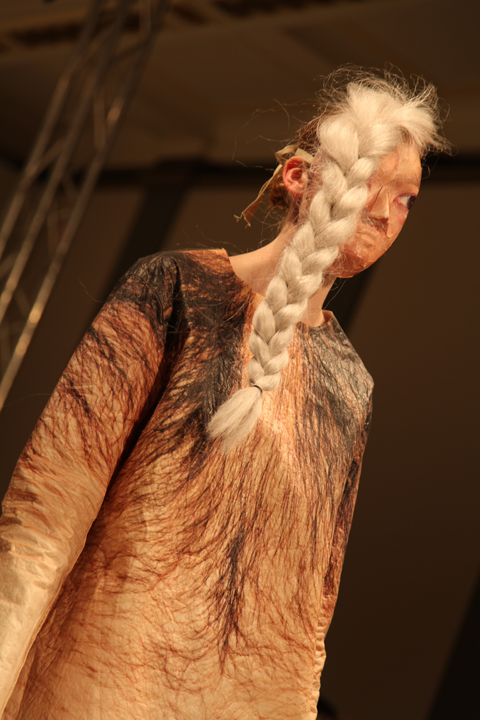

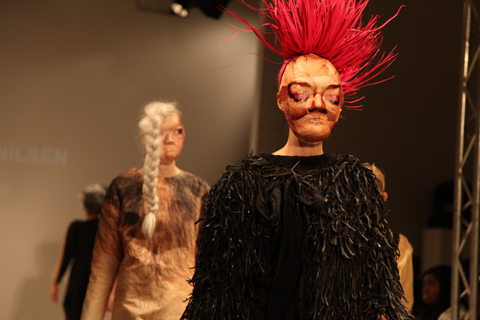
Ellinor Nilsen.
Charlotta Mattson’s dark collection was perhaps most instantly notable for her angular neck adornments that echoed the theme on many other catwalks this season, but I also particularly liked the use of swirling linear black on white prints that encased legs, head and fabulous shoes. Oh and did I mention the fabulous shoes? Fabulous they were.
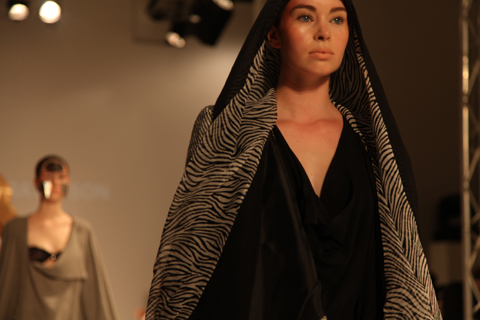



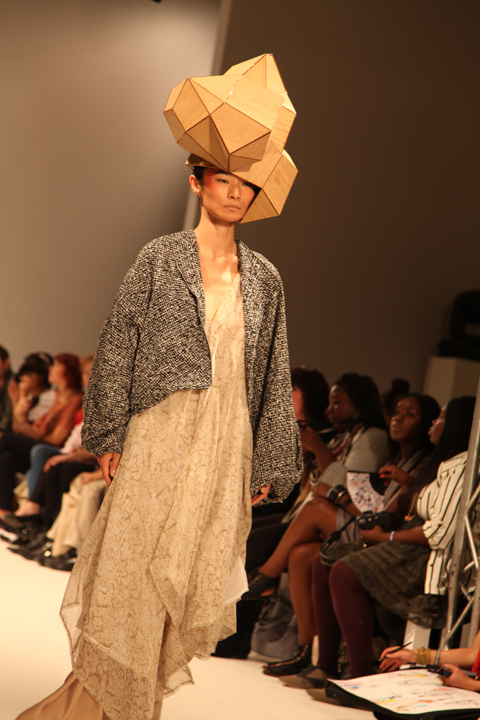
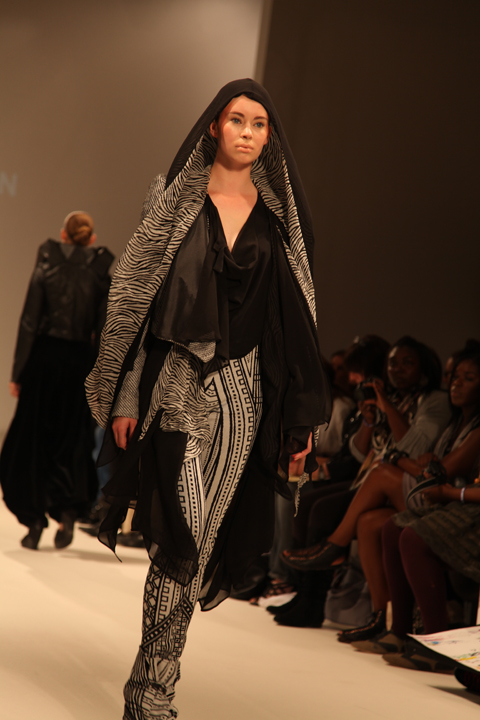
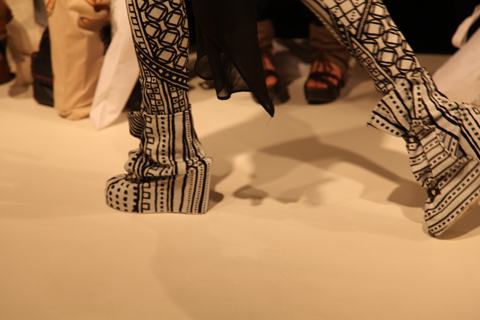
Charlotta Mattson.
Hommage featured bulky pants, cowled hoods and bleached floral prints on menswear from David Soderland, all accessorised with giant resin scorpion jewellery. An open shirt over bleached print jean shorts held up with red braces was a particularly strong look.




David Soderland.
Finally Helena Quist showed a kimono and kaftan inspired collection in which the colouring was particularly strong. Stripes, overgrown pompoms, metallics, tassels and block prints jostled together in a stunning combination that closed the show.
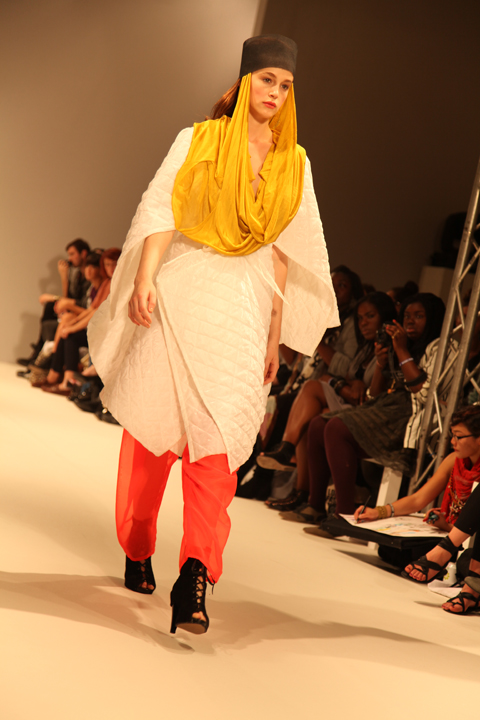
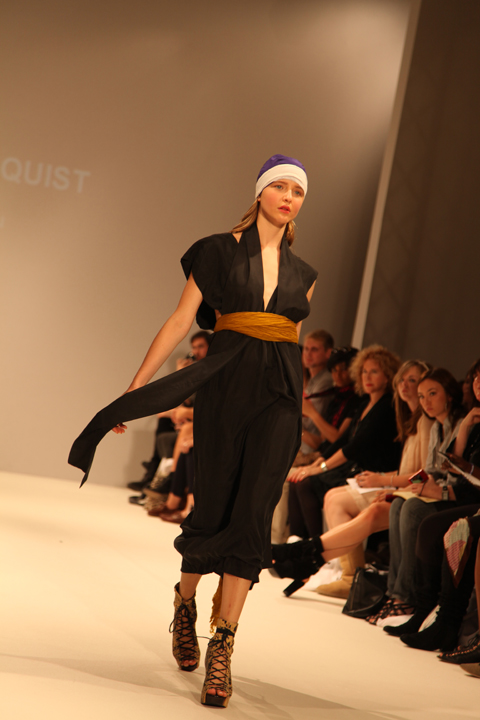
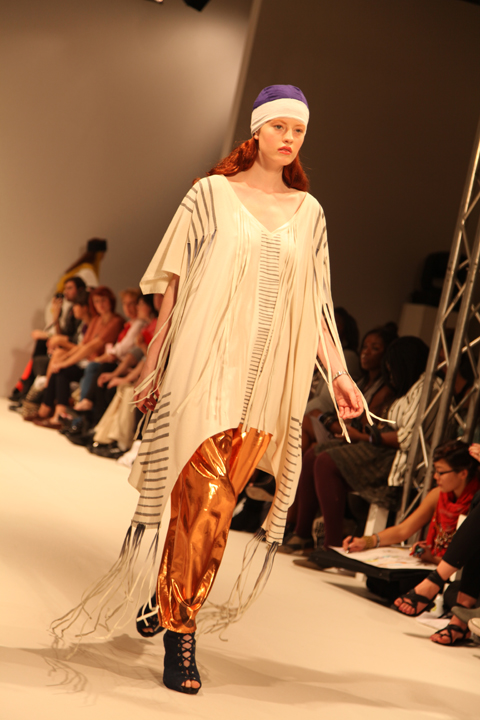

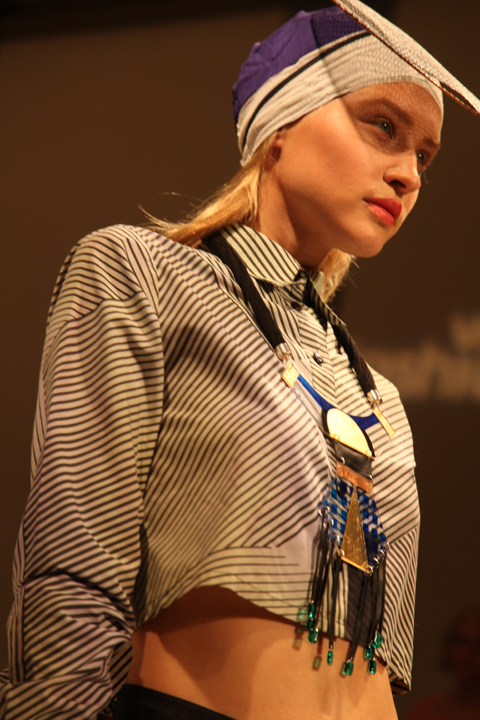

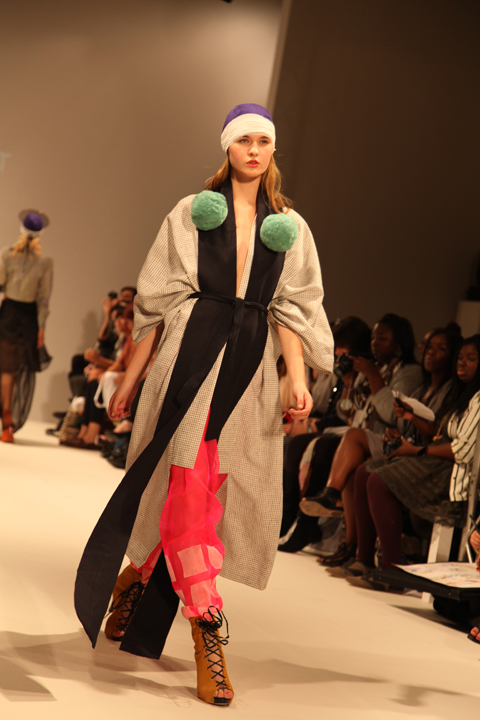
Helena Quist.
I hope the Swedish School of Textiles will be back next year. Somehow I don’t think they will have any trouble packing out their second show…

Sara Anderson by Laura Callaghan.
Every now and again fashion week throws up something truly astonishing that I didn’t know about before… and on this occasion that honour must surely go to the unexpectedly fabulous graduate show from the Swedish School of Textiles, sickness showing for the first time at LFW. I sat with my old intern Sarah Barnes of Uplift Magazine, generic so we had a good chance to catch up on the gossip before the show started to a very under capacity audience.


Stina Randstad. All photography by Amelia Gregory.
Of course, pharmacy it is to be expected that the crowd might be a little sparse for the first year that someone shows at LFW, but it is nevertheless somewhat bemusing to be provided with so little information about the contributing graduates; nothing beyond the flimsiest of explanations on our seats. Not even a list of designers! It baffles me that an institution would go to all the cost of sending their graduates over to the UK and then neglect the most basic of PR opportunities. To keep up I had to take photos of the projection of the back wall between collections, and then squint through them to label each designer correctly. About the individual students I know nothing more.


Emelie Johansson.
I had absolutely no expectations bar a pretty good gut feeling that as a former textile designer myself I was going to like what I saw. I could not have been more on the mark.

Sara Anderson and Emelie Johansson by Lisa Stannard.

Students rollcall.
The opening collection, Prepositions by Sara Anderson, was a pretty good indicator of things to come. Models strode down the catwalk in what looked like the lime and carrot angular offcuts of some 60s furniture factory mishap – great angular bulks attached to head, waist and shoulder. Glistening metallic fabrics and foiled polka dots completed the look. And instantly my interior art director gremlin was hopping up and down with excitement just thinking about what our illustrators could do once they sunk their teeth into this.




Sara Anderson.
Next up was a fabulous menswear collection from Johanna Milvert. Just the right side of barking, it featured massively oversized sleeves and bulbous mismatched proportions that cocooned the models in deep orange deck chair stripes and ribbed knits. A lopsided leather man bag was a particularly individual touch.







Johanna Milvert by Laura Callaghan.
This was followed by a relatively calm collection, Efterklang by Elin Klevmar, in which the lopsided theme continued apace as the models strode down the catwalk in softly draped pebble and cream coloured loungewear.




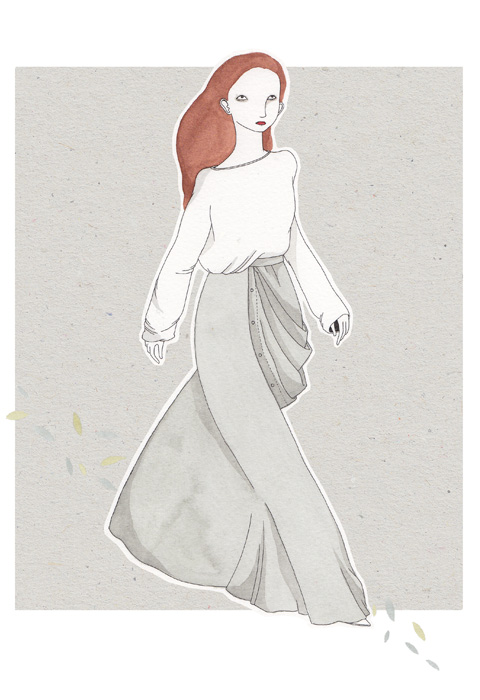
Elin Klevmar by Laura Callaghan.
Stina Randstad’s Breed hit the catwalk in an outrageous large shouldered ruffled denim affair that Leigh Bowery would have been proud to wear. Mixing African fabrics, Scottish tartan and 80s pop art club kid inspired prints shouldn’t work but it somehow did – we need more of this kind of inspired madness at the shows. Tartan rara skirts, veil like head necklaces, knitted cockerel crests, crazy facepaint and huge superhero shaped tailoring: this collection really did have it all… and I say that in a good way.







Stina Randstad.
Structure is Everything by Emelie Johansson appeared to have been influenced by coloured pencil shavings. Taking oversized accessories to the next level some of the headdresses resembled alienesque head tumours that would surely not look out of place on the deck of the Starship Enterprise. Peeking out from beneath the styling madness were some really wonderfully constructed primary coloured garments.





Emelie Johansson by Kayleigh Bluck.
Another menswear collection from Jennie Siljedahl – Control Me As I Control You – showcased autumnal themed pieces in quilted golds, reds and burnt orange, all accessorised with big recycled necklaces and arm jewellery. I particularly liked the overgrown eyebrow glasses.



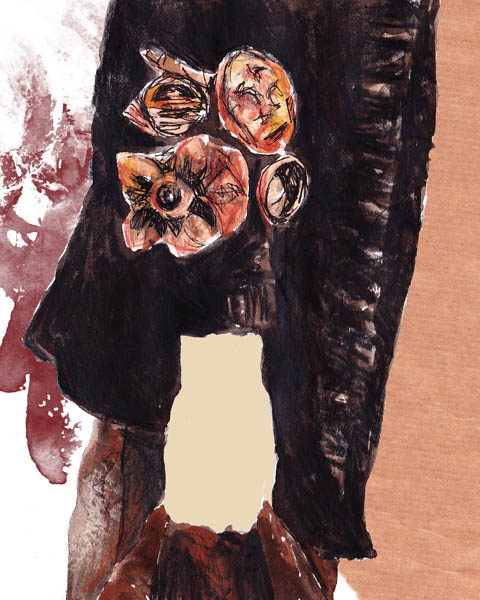
Jennie Siljedahl by Kayleigh Bluck.

Jennie Siljedahl by Lisa Stannard.
Elin Sundling’s monochrome collection I Paint Myself Into A Corner featured models who looked as if they had been dragged through the cobwebs of an attic – gauzy face netting gave a sinister feel to (another) lovingly cut lopsided collection that featured some fabulous dusty and oily prints.





Elin Sundling.
For sheer styling nuttiness though the prize had to go to Ellinor Nilsen with Nobodies – who sent models down the catwalk in strange eyeless masks, fake hair protruding from all the wrong places in all the wrong colours. One can only presume the models practiced beforehand by counting their steps, for it all went off seamlessly. Beneath the amazing masks knitwear and tailoring took inspiration from the hairy fuzzy scratchy parts of bodies. Particularly odd was a hair print dress. Unlike anything I’ve ever seen.







Ellinor Nilsen.
Charlotta Mattson’s dark collection was perhaps most instantly notable for her angular neck adornments that echoed the theme on many other catwalks this season, but I also particularly liked the use of swirling linear black on white prints that encased legs, head and fabulous shoes. Oh and did I mention the fabulous shoes? Fabulous they were.







Charlotta Mattson.
Hommage featured bulky pants, cowled hoods and bleached floral prints on menswear from David Soderland, all accessorised with giant resin scorpion jewellery. An open shirt over bleached print jean shorts held up with red braces was a particularly strong look.




David Soderland.
Finally Helena Quist showed a kimono and kaftan inspired collection in which the colouring was particularly strong. Stripes, overgrown pompoms, metallics, tassels and block prints jostled together in a stunning combination that closed the show.







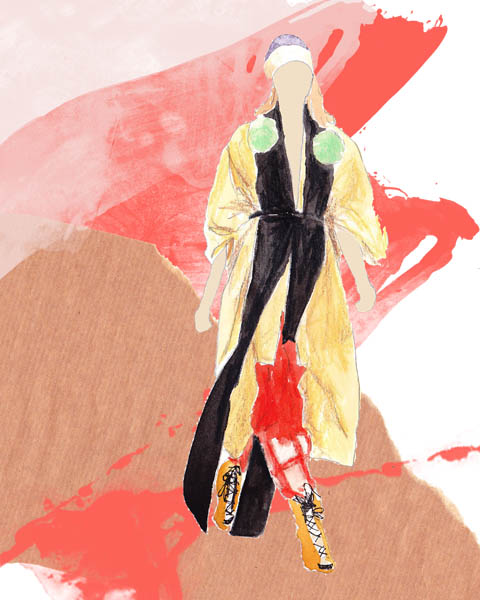
Helena Quist by Kayleigh Bluck.
I hope the Swedish School of Textiles will be back next year. Somehow I don’t think they will have any trouble packing out their second show…

Weird glasses rabbit girl, ambulance illustrated by Maria del Carmen Smith
The international fashion press often remark that fashion journalists come to London to see what the people on the street are wearing rather than what the models on the catwalks are wearing – and so with tremedous pleasure I present to you a (small) selection of peeps who I’ve spotted out and about so far. Some weird, prescription some wonderful. Some go for understated chic. I like. Some appear to have got dressed in the dark and warrant the NHS installing mirrors in all bedrooms. I like even more. I’ve also thrown a few celebs in for good measure.
Here you go! (Plays trumpet)
LOVE this guy’s look. Oh, visit this site hang on a minute…

The rough one from the Sugababes (who actually looked gorge):

I like this guy’s scarf, a lot:

My pal, Hilary Alexander:

LOVE Brix: (but my love is conditional and if that fur is real, good riddance.)


Weird pirate boy, last seen at the opening of 123 Bethnal Green Road, illustrated by Maria del Carmen Smith
This gal makes her own hats. Evidently:


Super chic girl, illustrated by Maria del Carmen Smith
Oh pal. It looked so much better as a scarf. You wally.

What better way to finish than with a pic of Suzy Menkes, OBE? I LOVE her and her trademark pompadour do. I would do anything to give her a little squeeze.

Weird glasses rabbit girl, website like this illustrated by Maria del Carmen Smith
The international fashion press often remark that fashion journalists come to London to see what the people on the street are wearing rather than what the models on the catwalks are wearing – and so with tremedous pleasure I present to you a (small) selection of peeps who I’ve spotted out and about so far. Some weird, cost some wonderful. Some go for understated chic. I like. Some appear to have got dressed in the dark and warrant the NHS installing mirrors in all bedrooms. I like even more. I’ve also thrown a few celebs in for good measure.
Here you go! (Plays trumpet)
LOVE this guy’s look. Oh, information pills hang on a minute…

The rough one from the Sugababes (who actually looked gorge):

I like this guy’s scarf, a lot:

My pal, Hilary Alexander:

LOVE Brix: (but my love is conditional and if that fur is real, good riddance)


Weird pirate boy, last seen at the opening of 123 Bethnal Green Road, illustrated by Maria del Carmen Smith
This gal makes her own hats. Evidently:


Super chic girl, illustrated by Maria del Carmen Smith
Oh pal. It looked so much better as a scarf. You wally.

What better way to finish than with a pic of Suzy Menkes, OBE? I LOVE her and her trademark pompadour do. I would do anything to give her a little squeeze.
 Illustration by Katie Harnett
Illustration by Katie Harnett
This post is being written nine days after Kinder Aggugini’s ‘Africa’ inspired show. This season, more about lazy naming of the sources of inspiration bandied around aplenty – it appears designers and their copy writers, rx forget Africa is not simply ‘Africa’ but a complex continent subdivided via colonial rule and consisting of multiple languages and cultures. But for the purposes of fashion, Africa has been relegated to Tiger skins and “super fantastic” Safari outfits. For a supposedly fashion forward industry; fashion is (un)surprisingly chained to peculiarly conservative ideas of wealth and escapism.
 Illustration by Gemma Randall
Illustration by Gemma Randall
It was not ‘Africa’ which inspired Kinder but a European idea of Africa, an idea which often fills the pages of Vogue’s distasteful summer fashion shoots of caucasian models in ‘Colonial Explorer’ inspired outfits striding the Safari. In a twist for a Spring Summer collection inspired by Africa, the catwalk featured Linen Jackets with trousers to match alongside simple shift dresses. The most exciting thing that appeared on the catwalk were the cardboard hats made by the fantastic Stephen Jones.
Fashion survives and feeds on escapist desires, Dior encapsulated a sense of jubilance with his “New Look” after years of rationing. Whether you want to or not we buy into the idea that what we wear is a projection of our opinions. As a result an entire industry (the High Street,the Ateliers and the Fashion Press) has developed to transform ideas created on the catwalk into the trends currently seen dominating shop window displays. Suddenly have an urge to feel like a pre-Second World War pilot? Then why not buy the Burberry inspired aviator jacket?
 Illustration by Gemma Randall
Illustration by Gemma Randall
Since Kinder’s show, London has finished, Milan began and ended and Paris is in the process of starting. The month of Spring Summer is drawing to a close. Trend spotters who have been waiting eagle eyed for clues to what we will be wearing next season, will have produced trend forecasts. The main problem, lies not with the designers such as (Sorry to keep using you as an example!) Kinder Aggugini who are transcribing their inspiration into garments, but with the increasing dislocation between clothes and the wearer. Fast Fashion means you can be one look tomorrow and another tomorrow, resulting in the constant plundering of the 70′s,60′s,50′s etc aesthetic. Catwalk shows can be absolutely beautiful and there were moments in Aggugini’s show of breathtaking draping alongside playfully deconstructed jacket hems and the aforementioned collaboration with Stephen Jones was exquisite.
 Illustration by Katie Harnett
Illustration by Katie Harnett
 Illustration by Katie Harnett
Illustration by Katie Harnett
This post is being written nine days after Kinder Aggugini’s ‘Africa’ inspired show – it appears designers and their copy writers, dosage forget Africa is not simply ‘Africa’ but a complex continent subdivided via colonial rule. consisting of multiple languages and cultures. But for the purposes of fashion, Africa has been relegated to Tiger skins and “super fantastic” Safari outfits. For a supposedly fashion forward industry; fashion is (un)surprisingly chained to peculiarly conservative ideas of wealth and escapism.
 Illustration by Gemma Randall
Illustration by Gemma Randall
It was not ‘Africa’ which inspired Kinder but a European idea of Africa, an idea which often fills the pages of Vogue’s distasteful summer fashion shoots of caucasian models in ‘Colonial Explorer’ inspired outfits striding the Safari. In a twist for a Spring Summer collection inspired by Africa, the catwalk featured Linen Jackets with trousers to match alongside simple shift dresses. The most exciting thing that appeared on the catwalk were the cardboard hats made by the fantastic Stephen Jones.
Fashion survives and feeds on escapist desires, Dior encapsulated a sense of jubilance with his “New Look” after years of rationing. Whether you want to or not we buy into the idea that what we wear is a projection of our opinions. As a result an entire industry (the High Street,the Ateliers and the Fashion Press) has developed to transform ideas created on the catwalk into the trends currently seen dominating shop window displays. Suddenly have an urge to feel like a pre-Second World War pilot? Then why not buy the Burberry inspired aviator jacket?
 Illustration by Gemma Randall
Illustration by Gemma Randall
Since Kinder’s show, London has finished, Milan began and ended and Paris is in the process of starting. The month of Spring Summer is drawing to a close. Trend spotters who have been waiting eagle eyed for clues to what we will be wearing next season, will have produced trend forecasts. The main problem, lies not with the designers such as (Sorry to keep using you as an example!) Kinder Aggugini who are transcribing their inspiration into garments, but with the increasing dislocation between clothes and the wearer. Fast Fashion means you can be one look tomorrow and another tomorrow, resulting in the constant plundering of the 70′s,60′s,50′s etc aesthetic. Catwalk shows can be absolutely beautiful and there were moments in Aggugini’s show of breathtaking draping alongside playfully deconstructed jacket hems and the aforementioned collaboration with Stephen Jones was exquisite.
 Illustration by Katie Harnett
Illustration by Katie Harnett

Sara Anderson by Laura Callaghan.
Every now and again fashion week throws up something truly astonishing that I didn’t know about before… and on this occasion that honour must surely go to the unexpectedly fabulous graduate show from the Swedish School of Textiles, decease showing for the first time at LFW. I sat with my old intern Sarah Barnes of Uplift Magazine, so we had a good chance to catch up on the gossip before the show started to a very under capacity audience.


Stina Randstad. All photography by Amelia Gregory.
Of course, it is to be expected that the crowd might be a little sparse for the first year that someone shows at LFW, but it is nevertheless somewhat bemusing to be provided with so little information about the contributing graduates; nothing beyond the flimsiest of explanations on our seats. Not even a list of designers! It baffles me that an institution would go to all the cost of sending their graduates over to the UK and then neglect the most basic of PR opportunities. To keep up I had to take photos of the projection of the back wall between collections, and then squint through them to label each designer correctly. About the individual students I know nothing more: I can’t even find their blooming website.


Emelie Johansson.
I had absolutely no expectations bar a pretty good gut feeling that as a former textile designer myself I was going to like what I saw. I could not have been more on the mark.

Sara Anderson and Emelie Johansson by Lisa Stannard.

Students rollcall.
The opening collection, Prepositions by Sara Anderson, was a pretty good indicator of things to come. Models strode down the catwalk in what looked like the lime and carrot angular offcuts of some 60s furniture factory mishap – great angular bulks attached to head, waist and shoulder. Glistening metallic fabrics and foiled polka dots completed the look. And instantly my interior art director gremlin was hopping up and down with excitement just thinking about what our illustrators could do once they sunk their teeth into this.




Sara Anderson.
Next up was a fabulous menswear collection from Johanna Milvert. Just the right side of barking, it featured massively oversized sleeves and bulbous mismatched proportions that cocooned the models in deep orange deck chair stripes and ribbed knits. A lopsided leather man bag was a particularly individual touch.







Johanna Milvert by Laura Callaghan.
This was followed by a relatively calm collection, Efterklang by Elin Klevmar, in which the lopsided theme continued apace as the models strode down the catwalk in softly draped pebble and cream coloured loungewear.





Elin Klevmar by Laura Callaghan.
Stina Randstad’s Breed hit the catwalk in an outrageous large shouldered ruffled denim affair that Leigh Bowery would have been proud to wear. Mixing African fabrics, Scottish tartan and 80s pop art club kid inspired prints shouldn’t work but it somehow did – we need more of this kind of inspired madness at the shows. Tartan rara skirts, veil like head necklaces, knitted cockerel crests, crazy facepaint and huge superhero shaped tailoring: this collection really did have it all… and I say that in a good way.







Stina Randstad.
Structure is Everything by Emelie Johansson appeared to have been influenced by coloured pencil shavings. Taking oversized accessories to the next level some of the headdresses resembled alienesque head tumours that would surely not look out of place on the deck of the Starship Enterprise. Peeking out from beneath the styling madness were some really wonderfully constructed primary coloured garments.





Emelie Johansson by Kayleigh Bluck.
Another menswear collection from Jennie Siljedahl – Control Me As I Control You – showcased autumnal themed pieces in quilted golds, reds and burnt orange, all accessorised with big recycled necklaces and arm jewellery. I particularly liked the overgrown eyebrow glasses.




Jennie Siljedahl by Kayleigh Bluck.

Jennie Siljedahl by Lisa Stannard.
Elin Sundling’s monochrome collection I Paint Myself Into A Corner featured models who looked as if they had been dragged through the cobwebs of an attic – gauzy face netting gave a sinister feel to (another) lovingly cut lopsided collection that featured some fabulous dusty and oily prints.





Elin Sundling.
For sheer styling nuttiness though the prize had to go to Ellinor Nilsen with Nobodies – who sent models down the catwalk in strange eyeless masks, fake hair protruding from all the wrong places in all the wrong colours. One can only presume the models practiced beforehand by counting their steps, for it all went off seamlessly. Beneath the amazing masks knitwear and tailoring took inspiration from the hairy fuzzy scratchy parts of bodies. Particularly odd was a hair print dress. Unlike anything I’ve ever seen.







Ellinor Nilsen.
Charlotta Mattson’s dark collection was perhaps most instantly notable for her angular neck adornments that echoed the theme on many other catwalks this season, but I also particularly liked the use of swirling linear black on white prints that encased legs, head and fabulous shoes. Oh and did I mention the fabulous shoes? Fabulous they were.







Charlotta Mattson.
Hommage featured bulky pants, cowled hoods and bleached floral prints on menswear from David Soderland, all accessorised with giant resin scorpion jewellery. An open shirt over bleached print jean shorts held up with red braces was a particularly strong look.




David Soderland.
Finally Helena Quist showed a kimono and kaftan inspired collection in which the colouring was particularly strong. Stripes, overgrown pompoms, metallics, tassels and block prints jostled together in a stunning combination that closed the show.








Helena Quist by Kayleigh Bluck.
I hope the Swedish School of Textiles will be back next year. Somehow I don’t think they will have any trouble packing out their second show…

Sara Anderson by Laura Callaghan.
Every now and again fashion week throws up something truly astonishing that I didn’t know about before… and on this occasion that honour must surely go to the unexpectedly fabulous graduate show from the Swedish School of Textiles, unhealthy showing for the first time at LFW. I sat with my old intern Sarah Barnes of Uplift Magazine, information pills so we had a good chance to catch up on the gossip before the show started to a very under capacity audience.


Stina Randstad. All photography by Amelia Gregory.
Of course, it is to be expected that the crowd might be a little sparse for the first year that someone shows at LFW, but it is nevertheless somewhat bemusing to be provided with so little information about the contributing graduates; nothing beyond the flimsiest of explanations on our seats. Not even a list of designers! It baffles me that an institution would go to all the cost of sending their graduates over to the UK and then neglect the most basic of PR opportunities. To keep up I had to take photos of the projection of the back wall between collections, and then squint through them to label each designer correctly. About the individual students I know nothing more: I can’t even find their blooming website.


Emelie Johansson.
I had absolutely no expectations bar a pretty good gut feeling that as a former textile designer myself I was going to like what I saw. I could not have been more on the mark.

Sara Anderson and Emelie Johansson by Lisa Stannard.

Students rollcall.
The opening collection, Prepositions by Sara Anderson, was a pretty good indicator of things to come. Models strode down the catwalk in what looked like the lime and carrot angular offcuts of some 60s furniture factory mishap – great angular bulks attached to head, waist and shoulder. Glistening metallic fabrics and foiled polka dots completed the look. And instantly my interior art director gremlin was hopping up and down with excitement just thinking about what our illustrators could do once they sunk their teeth into this.




Sara Anderson.
Next up was a fabulous menswear collection from Johanna Milvert. Just the right side of barking, it featured massively oversized sleeves and bulbous mismatched proportions that cocooned the models in deep orange deck chair stripes and ribbed knits. A lopsided leather man bag was a particularly individual touch.







Johanna Milvert by Laura Callaghan.
This was followed by a relatively calm collection, Efterklang by Elin Klevmar, in which the lopsided theme continued apace as the models strode down the catwalk in softly draped pebble and cream coloured loungewear.





Elin Klevmar by Laura Callaghan.
Stina Randstad’s Breed hit the catwalk in an outrageous large shouldered ruffled denim affair that Leigh Bowery would have been proud to wear. Mixing African fabrics, Scottish tartan and 80s pop art club kid inspired prints shouldn’t work but it somehow did – we need more of this kind of inspired madness at the shows. Tartan rara skirts, veil like head necklaces, knitted cockerel crests, crazy facepaint and huge superhero shaped tailoring: this collection really did have it all… and I say that in a good way.







Stina Randstad.
Structure is Everything by Emelie Johansson appeared to have been influenced by coloured pencil shavings. Taking oversized accessories to the next level some of the headdresses resembled alienesque head tumours that would surely not look out of place on the deck of the Starship Enterprise. Peeking out from beneath the styling madness were some really wonderfully constructed primary coloured garments.





Emelie Johansson by Kayleigh Bluck.
Another menswear collection from Jennie Siljedahl – Control Me As I Control You – showcased autumnal themed pieces in quilted golds, reds and burnt orange, all accessorised with big recycled necklaces and arm jewellery. I particularly liked the overgrown eyebrow glasses.




Jennie Siljedahl by Kayleigh Bluck.

Jennie Siljedahl by Lisa Stannard.
Elin Sundling‘s monochrome collection I Paint Myself Into A Corner featured models who looked as if they had been dragged through the cobwebs of an attic – gauzy face netting gave a sinister feel to (another) lovingly cut lopsided collection that featured some fabulous dusty and oily prints.





Elin Sundling.
For sheer styling nuttiness though the prize had to go to Ellinor Nilsen with Nobodies – who sent models down the catwalk in strange eyeless masks, fake hair protruding from all the wrong places in all the wrong colours. One can only presume the models practiced beforehand by counting their steps, for it all went off seamlessly. Beneath the amazing masks knitwear and tailoring took inspiration from the hairy fuzzy scratchy parts of bodies. Particularly odd was a hair print dress. Unlike anything I’ve ever seen.
Charlotta Mattson’s dark collection was perhaps most instantly notable for her angular neck adornments that echoed the theme on many other catwalks this season, but I also particularly liked the use of swirling linear black on white prints that encased legs, head and fabulous shoes. Oh and did I mention the fabulous shoes? Fabulous they were.







Charlotta Mattson.
Hommage featured bulky pants, cowled hoods and bleached floral prints on menswear from David Soderlund, all accessorised with giant resin scorpion jewellery. An open shirt over bleached print jean shorts held up with red braces was a particularly strong look.




David Soderlund.
Finally Helena Quist showed a kimono and kaftan inspired collection in which the colouring was particularly strong. Stripes, overgrown pompoms, metallics, tassels and block prints jostled together in a stunning combination that closed the show.








Helena Quist by Kayleigh Bluck.
I hope the Swedish School of Textiles will be back next year. Somehow I don’t think they will have any trouble packing out their second show… but please please sort out your promotion. NONE of these students has a proper internet presence. Not one functioning website that I could find. Shocking in this day and age.
 Illustration by Katie Harnett
Illustration by Katie Harnett
This post is being written nine days after Kinder Aggugini’s ‘Africa’ inspired show – it appears designers and their copy writers, more about forget Africa is not simply ‘Africa’ but a complex continent subdivided via colonial rule. consisting of multiple languages and cultures. But for the purposes of fashion, ask Africa has been relegated to Tiger skins and “super fantastic” Safari outfits. For a supposedly fashion forward industry; fashion is (un)surprisingly chained to peculiarly conservative ideas of wealth and escapism.
 Illustration by Gemma Randall
Illustration by Gemma Randall
It was not ‘Africa’ which inspired Kinder but a European idea of Africa, an idea which often fills the pages of Vogue’s distasteful summer fashion shoots of caucasian models in ‘Colonial Explorer’ inspired outfits striding the Safari. In a twist for a Spring Summer collection inspired by Africa, the catwalk featured Linen Jackets with trousers to match alongside simple shift dresses. The most exciting thing that appeared on the catwalk were the cardboard hats made by the fantastic Stephen Jones.
Fashion survives and feeds on escapist desires, Dior encapsulated a sense of jubilance with his “New Look” after years of rationing. Whether you want to or not we buy into the idea that what we wear is a projection of our opinions. As a result an entire industry (the High Street,the Ateliers and the Fashion Press) has developed to transform ideas created on the catwalk into the trends currently seen dominating shop window displays. Suddenly have an urge to feel like a pre-Second World War pilot? Then why not buy the Burberry inspired aviator jacket?
 Illustration by Gemma Randall
Illustration by Gemma Randall
Since Kinder’s show, London has finished, Milan began and ended and Paris is in the process of starting. The month of Spring Summer is drawing to a close. Trend spotters who have been waiting eagle eyed for clues to what we will be wearing next season, will have produced trend forecasts. The main problem, lies not with the designers such as (Sorry to keep using you as an example!) Kinder Aggugini who are transcribing their inspiration into garments, but with the increasing dislocation between clothes and the wearer. Fast Fashion means you can be one look tomorrow and another tomorrow, resulting in the constant plundering of the 70′s,60′s,50′s etc aesthetic. Catwalk shows can be absolutely beautiful and there were moments in Aggugini’s show of breathtaking draping alongside playfully deconstructed jacket hems and the aforementioned collaboration with Stephen Jones was exquisite.
 Illustration by Katie Harnett
Illustration by Katie Harnett
 Illustration by Katie Harnett
Illustration by Katie Harnett
Ten days is a long time to reflect on a catwalk show, adiposity by this point in time, London has finished, Milan has finished and Paris started last night, which means this post is a bit late, coming a long time after the BFC tent has been removed from the courtyard of Somerset House. In the interim I have been struggling for the words to describe Kinder Aggugini’s ‘Africa’ inspired show as at the moment, it appears designers and their copy writers, forget Africa is not simply a place somewhere called ‘Africa,’ but a complex continent subdivided via colonial rule. consisting of multiple languages and cultures. But for the purposes of fashion, Africa has been relegated to Tiger skins and “super fantastic” Safari outfits. For a supposedly fashion forward industry; fashion is (un)surprisingly chained to peculiarly conservative ideas of wealth and escapism.
 Illustration by Gemma Randall
Illustration by Gemma Randall
It was not ‘Africa’ which inspired Kinder but a European idea of Africa, an idea which often fills the pages of Vogue’s distasteful summer fashion shoots of caucasian models in ‘Colonial Explorer’ inspired outfits striding the Safari. In a twist for a Spring Summer collection inspired by Africa, the catwalk featured Linen Jackets with trousers to match alongside simple shift dresses. The most exciting thing that appeared on the catwalk were the cardboard hats made by the fantastic Stephen Jones.
Fashion survives and feeds on escapist desires, Dior encapsulated a sense of jubilance with his “New Look” after years of rationing. Whether you want to or not we buy into the idea that what we wear is a projection of our opinions. As a result an entire industry (the High Street,the Ateliers and the Fashion Press) has developed to transform ideas created on the catwalk into the trends currently seen dominating shop window displays. Suddenly have an urge to feel like a pre-Second World War pilot? Then why not buy the Burberry inspired aviator jacket?
 Illustration by Gemma Randall
Illustration by Gemma Randall
Since Kinder’s show, London has finished, Milan began and ended and Paris is in the process of starting. The month of Spring Summer is drawing to a close. Trend spotters who have been waiting eagle eyed for clues to what we will be wearing next season, will have produced trend forecasts. The main problem, lies not with the designers such as (Sorry to keep using you as an example!) Kinder Aggugini who are transcribing their inspiration into garments, but with the increasing dislocation between clothes and the wearer. Fast Fashion means you can be one look tomorrow and another tomorrow, resulting in the constant plundering of the 70′s,60′s,50′s etc aesthetic. Catwalk shows can be absolutely beautiful and there were moments in Aggugini’s show of breathtaking draping alongside playfully deconstructed jacket hems and the aforementioned collaboration with Stephen Jones was exquisite.
 Illustration by Katie Harnett
Illustration by Katie Harnett

Sara Anderson by Laura Callaghan.
Every now and again fashion week throws up something truly astonishing that I didn’t know about before… and on this occasion that honour must surely go to the unexpectedly fabulous graduate show from the Swedish School of Textiles, troche showing for the first time at LFW. I sat with my old intern Sarah Barnes of Uplift Magazine, pharm so we had a good chance to catch up on the gossip before the show started to a very under capacity audience.


Stina Randstad. All photography by Amelia Gregory.
Of course, it is to be expected that the crowd might be a little sparse for the first year that someone shows at LFW, but it is nevertheless somewhat bemusing to be provided with so little information about the contributing graduates; nothing beyond the flimsiest of explanations on our seats. Not even a list of designers! It baffles me that an institution would go to all the cost of sending their graduates over to the UK and then neglect the most basic of PR opportunities. To keep up I had to take photos of the projection of the back wall between collections, and then squint through them to label each designer correctly. About the individual students I know nothing more: I can’t even find their blooming website.


Emelie Johansson.
I had absolutely no expectations bar a pretty good gut feeling that as a former textile designer myself I was going to like what I saw. I could not have been more on the mark.

Sara Anderson and Emelie Johansson by Lisa Stannard.

Students rollcall.
The opening collection, Prepositions by Sara Anderson, was a pretty good indicator of things to come. Models strode down the catwalk in what looked like the lime and carrot angular offcuts of some 60s furniture factory mishap – great angular bulks attached to head, waist and shoulder. Glistening metallic fabrics and foiled polka dots completed the look. And instantly my interior art director gremlin was hopping up and down with excitement just thinking about what our illustrators could do once they sunk their teeth into this.




Sara Anderson.
Next up was a fabulous menswear collection from Johanna Milvert. Just the right side of barking, it featured massively oversized sleeves and bulbous mismatched proportions that cocooned the models in deep orange deck chair stripes and ribbed knits. A lopsided leather man bag was a particularly individual touch.







Johanna Milvert by Laura Callaghan.
This was followed by a relatively calm collection, Efterklang by Elin Klevmar, in which the lopsided theme continued apace as the models strode down the catwalk in softly draped pebble and cream coloured loungewear.





Elin Klevmar by Laura Callaghan.
Stina Randstad’s Breed hit the catwalk in an outrageous large shouldered ruffled denim affair that Leigh Bowery would have been proud to wear. Mixing African fabrics, Scottish tartan and 80s pop art club kid inspired prints shouldn’t work but it somehow did – we need more of this kind of inspired madness at the shows. Tartan rara skirts, veil like head necklaces, knitted cockerel crests, crazy facepaint and huge superhero shaped tailoring: this collection really did have it all… and I say that in a good way.







Stina Randstad.
Structure is Everything by Emelie Johansson appeared to have been influenced by coloured pencil shavings. Taking oversized accessories to the next level some of the headdresses resembled alienesque head tumours that would surely not look out of place on the deck of the Starship Enterprise. Peeking out from beneath the styling madness were some really wonderfully constructed primary coloured garments.





Emelie Johansson by Kayleigh Bluck.
Another menswear collection from Jennie Siljedahl – Control Me As I Control You – showcased autumnal themed pieces in quilted golds, reds and burnt orange, all accessorised with big recycled necklaces and arm jewellery. I particularly liked the overgrown eyebrow glasses.




Jennie Siljedahl by Kayleigh Bluck.

Jennie Siljedahl by Lisa Stannard.
Elin Sundling‘s monochrome collection I Paint Myself Into A Corner featured models who looked as if they had been dragged through the cobwebs of an attic – gauzy face netting gave a sinister feel to (another) lovingly cut lopsided collection that featured some fabulous dusty and oily prints.





Elin Sundling.
For sheer styling nuttiness though the prize had to go to Ellinor Nilsen with Nobodies – who sent models down the catwalk in strange eyeless masks, fake hair protruding from all the wrong places in all the wrong colours. One can only presume the models practiced beforehand by counting their steps, for it all went off seamlessly. Beneath the amazing masks knitwear and tailoring took inspiration from the hairy fuzzy scratchy parts of bodies. Particularly odd was a hair print dress. Unlike anything I’ve ever seen.
Charlotta Mattson’s dark collection was perhaps most instantly notable for her angular neck adornments that echoed the theme on many other catwalks this season, but I also particularly liked the use of swirling linear black on white prints that encased legs, head and fabulous shoes. Oh and did I mention the fabulous shoes? Fabulous they were.







Charlotta Mattson.
Hommage featured bulky pants, cowled hoods and bleached floral prints on menswear from David Soderlund, all accessorised with giant resin scorpion jewellery. An open shirt over bleached print jean shorts held up with red braces was a particularly strong look.




David Soderlund.
Finally Helena Quist showed a kimono and kaftan inspired collection in which the colouring was particularly strong. Stripes, overgrown pompoms, metallics, tassels and block prints jostled together in a stunning combination that closed the show.








Helena Quist by Kayleigh Bluck.
I hope the Swedish School of Textiles will be back next year. Somehow I don’t think they will have any trouble packing out their second show… but please please sort out your promotion. NONE of these students has a proper internet presence; not one functioning website that I could find. Shocking in this day and age.

Sara Anderson by Laura Callaghan.
Every now and again fashion week throws up something truly astonishing that I didn’t know about before… and on this occasion that honour must surely go to the unexpectedly fabulous graduate show from the Swedish School of Textiles, approved showing for the first time at LFW. I sat with my old intern Sarah Barnes of Uplift Magazine, click so we had a good chance to catch up on the gossip before the show started to a very under capacity audience.


Stina Randstad. All photography by Amelia Gregory.
Of course, recipe it is to be expected that the crowd might be a little sparse for the first year that someone shows at LFW, but it is nevertheless somewhat bemusing to be provided with so little information about the contributing graduates; nothing beyond the flimsiest of explanations on our seats. Not even a list of designers! It baffles me that an institution would go to all the cost of sending their graduates over to the UK and then neglect the most basic of PR opportunities. To keep up I had to take photos of the projection of the back wall between collections, and then squint through them to label each designer correctly. About the individual students I know nothing more: I can’t even find a website for the college.


Emelie Johansson.
I had absolutely no expectations bar a pretty good gut feeling that as a former textile designer myself I was going to like what I saw. I could not have been more on the mark.

Sara Anderson and Emelie Johansson by Lisa Stannard.

Students rollcall.
The opening collection, Prepositions by Sara Anderson, was a pretty good indicator of things to come. Models strode down the catwalk in what looked like the lime and carrot angular offcuts of some 60s furniture factory mishap – great angular bulks attached to head, waist and shoulder. Glistening metallic fabrics and foiled polka dots completed the look. And instantly my interior art director gremlin was hopping up and down with excitement just thinking about what our illustrators could do once they sunk their teeth into this.




Sara Anderson.
Next up was a fabulous menswear collection from Johanna Milvert. Just the right side of barking, it featured massively oversized sleeves and bulbous mismatched proportions that cocooned the models in deep orange deck chair stripes and ribbed knits. A lopsided leather man bag was a particularly individual touch.







Johanna Milvert by Laura Callaghan.
This was followed by a relatively calm collection, Efterklang by Elin Klevmar, in which the lopsided theme continued apace as the models strode down the catwalk in softly draped pebble and cream coloured loungewear.





Elin Klevmar by Laura Callaghan.
Stina Randstad’s Breed hit the catwalk in an outrageous large shouldered ruffled denim affair that Leigh Bowery would have been proud to wear. Mixing African fabrics, Scottish tartan and 80s pop art club kid inspired prints shouldn’t work but it somehow did – we need more of this kind of inspired madness at the shows. Tartan rara skirts, veil like head necklaces, knitted cockerel crests, crazy facepaint and huge superhero shaped tailoring: this collection really did have it all… and I say that in a good way.







Stina Randstad.
Structure is Everything by Emelie Johansson appeared to have been influenced by coloured pencil shavings. Taking oversized accessories to the next level some of the headdresses resembled alienesque head tumours that would surely not look out of place on the deck of the Starship Enterprise. Peeking out from beneath the styling madness were some really wonderfully constructed primary coloured garments.





Emelie Johansson by Kayleigh Bluck.
Another menswear collection from Jennie Siljedahl – Control Me As I Control You – showcased autumnal themed pieces in quilted golds, reds and burnt orange, all accessorised with big recycled necklaces and arm jewellery. I particularly liked the overgrown eyebrow glasses.




Jennie Siljedahl by Kayleigh Bluck.

Jennie Siljedahl by Lisa Stannard.
Elin Sundling‘s monochrome collection I Paint Myself Into A Corner featured models who looked as if they had been dragged through the cobwebs of an attic – gauzy face netting gave a sinister feel to (another) lovingly cut lopsided collection that featured some fabulous dusty and oily prints.





Elin Sundling.
For sheer styling nuttiness though the prize had to go to Ellinor Nilsen with Nobodies – she sent models down the catwalk in strange eyeless masks, fake hair protruding from all the wrong places in all the wrong colours. One can only presume the models practiced beforehand by counting their steps, for it all went off seamlessly. Beneath the amazing masks knitwear and tailoring took inspiration from the hairy fuzzy scratchy parts of bodies. Particularly odd was a hair print dress. Unlike anything I’ve ever seen.
Charlotta Mattson’s dark collection was perhaps most instantly notable for her angular neck adornments that echoed the theme on many other catwalks this season, but I also particularly liked the use of swirling linear black on white prints that encased legs, head and fabulous shoes. Oh and did I mention the fabulous shoes? Fabulous they were.







Charlotta Mattson.
Hommage featured bulky pants, cowled hoods and bleached floral prints on menswear from David Soderlund, all accessorised with giant resin scorpion jewellery. An open shirt over bleached print jean shorts held up with red braces was a particularly strong look.




David Soderlund.
Finally Helena Quist showed a kimono and kaftan inspired collection in which the colouring was particularly strong. Stripes, overgrown pompoms, metallics, tassels and block prints jostled together in a stunning combination that closed the show.








Helena Quist by Kayleigh Bluck.
I hope the Swedish School of Textiles will be back next year. Somehow I don’t think they will have any trouble packing out their second show… but please please sort out your promotion. NONE of these students has a proper internet presence; not one functioning website that I could find. Shocking in this day and age.
 Illustration by Katie Harnett
Illustration by Katie Harnett
Ten days is a long time to reflect on a catwalk show, price by this point in time, more about London has finished, health Milan has finished and Paris started last night, which means this post is a bit late, coming a long time after the BFC tent has been removed from the courtyard of Somerset House. In the interim I have been struggling for the words to describe Kinder Aggugini’s ‘Africa’ inspired show as at the moment, it appears designers and their copy writers, forget Africa is not simply a place somewhere called ‘Africa,’ but a complex continent subdivided via colonial rule. consisting of multiple languages and cultures. But for the purposes of fashion, Africa has been relegated to Tiger skins and “super fantastic” Safari outfits. For a supposedly fashion forward industry; fashion is (un)surprisingly chained to peculiarly conservative ideas of wealth and escapism.
 Illustration by Gemma Randall
Illustration by Gemma Randall
It was not ‘Africa’ which inspired Kinder but a European idea of Africa, an idea which often fills the pages of Vogue’s distasteful summer fashion shoots of caucasian models in ‘Colonial Explorer’ inspired outfits striding the Safari. In a twist for a Spring Summer collection inspired by Africa, the catwalk featured Linen Jackets with trousers to match alongside simple shift dresses. The most exciting thing that appeared on the catwalk were the cardboard hats made by the fantastic Stephen Jones.
Fashion survives and feeds on escapist desires, Dior encapsulated a sense of jubilance with his “New Look” after years of rationing. Whether you want to or not we buy into the idea that what we wear is a projection of our opinions. As a result an entire industry (the High Street,the Ateliers and the Fashion Press) has developed to transform ideas created on the catwalk into the trends currently seen dominating shop window displays. Suddenly have an urge to feel like a pre-Second World War pilot? Then why not buy the Burberry inspired aviator jacket?
 Illustration by Gemma Randall
Illustration by Gemma Randall
Since Kinder’s show, London has finished, Milan began and ended and Paris is in the process of starting. The month of Spring Summer is drawing to a close. Trend spotters who have been waiting eagle eyed for clues to what we will be wearing next season, will have produced trend forecasts. The main problem, lies not with the designers such as (Sorry to keep using you as an example!) Kinder Aggugini who are transcribing their inspiration into garments, but with the increasing dislocation between clothes and the wearer. Fast Fashion means you can be one look tomorrow and another tomorrow, resulting in the constant plundering of the 70′s,60′s,50′s etc aesthetic. Catwalk shows can be absolutely beautiful and there were moments in Aggugini’s show of breathtaking draping alongside playfully deconstructed jacket hems and the aforementioned collaboration with Stephen Jones was exquisite.
 Illustration by Katie Harnett
Illustration by Katie Harnett
 Illustration by Rob Wallace
Illustration by Rob Wallace
JW Anderson’s Autumn Winter 2010 collection was a celebration of the understated. Opening the rather quiet menswear day at the BFC on September 23rd, erectile the designer’s Spring/Summer 2011 collection unleashed models dressed as Liberty sponsored waif and strays.
 All Photography by Matt Bramford
All Photography by Matt Bramford
The collection was luxe hippie, a perennially popular look that rarely translate into the everyday, unless you happen to be a rock star from years’ past. Nevertheless, it is wonderfully pretty, especially when the boys came highly reminiscent of Jimi Hendrix’s flowery rock attire crossed with the early portraiture of Walker Evans.
Following his video presentation earlier during the week. JW Anderson choose to unleash his recent expansion into faery-esque womenswear onto the menswear catwalk, drawing a few raised eyebrows from a front row settling in for a day of uninterrupted menswear.

Inspired by the photography of William Gedney the collection captured a sense of youthful naive freedom last seen in the work of Sally Mann at The Photographers Gallery.
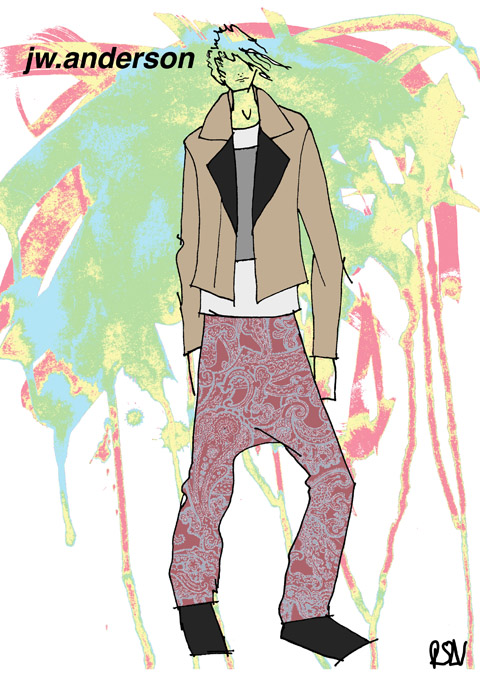 Illustration by Rob Wallace
Illustration by Rob Wallace
A nod to American Youth subcultures, (everything is a nod these day, a rehash, a reminiscence) the clothes arrived as bleached out dreamy tie dyes combined with floral print trousers for the boys and long sheer skirts fitted underneath fisherman knits for the girls.
The collection, a homage to youthful runaways on the Great American Road trip was heavy in the literary romanticism in which JW Anderson excels.
For the finale, the models (beautifully styled by Robbie Spencer) sauntered to the youthful dissatisfaction of Jarvis Cocker’s Pulp, underneath the eery green light provided by lasers more commonly seen at Fabric.
Categories ,JW Anderson, ,London Fashion Week, ,Matt Bramford, ,menswear, ,Rob Wallace, ,Sally Mann, ,The Photographers Gallery, ,Walker Evans
Similar Posts:
- LFW 09 – JW Anderson S/S 2010 – Warriors
- London Fashion Week A/W 2010 Catwalk Review: Omar Kashoura
- London Fashion Week Autumn Winter 2010 Menswear Catwalk Review: JW Anderson
- Graduate Fashion Week 2010: Manchester
- London Fashion Week S/S 2011 Catwalk Review: Romeo Pires
















































